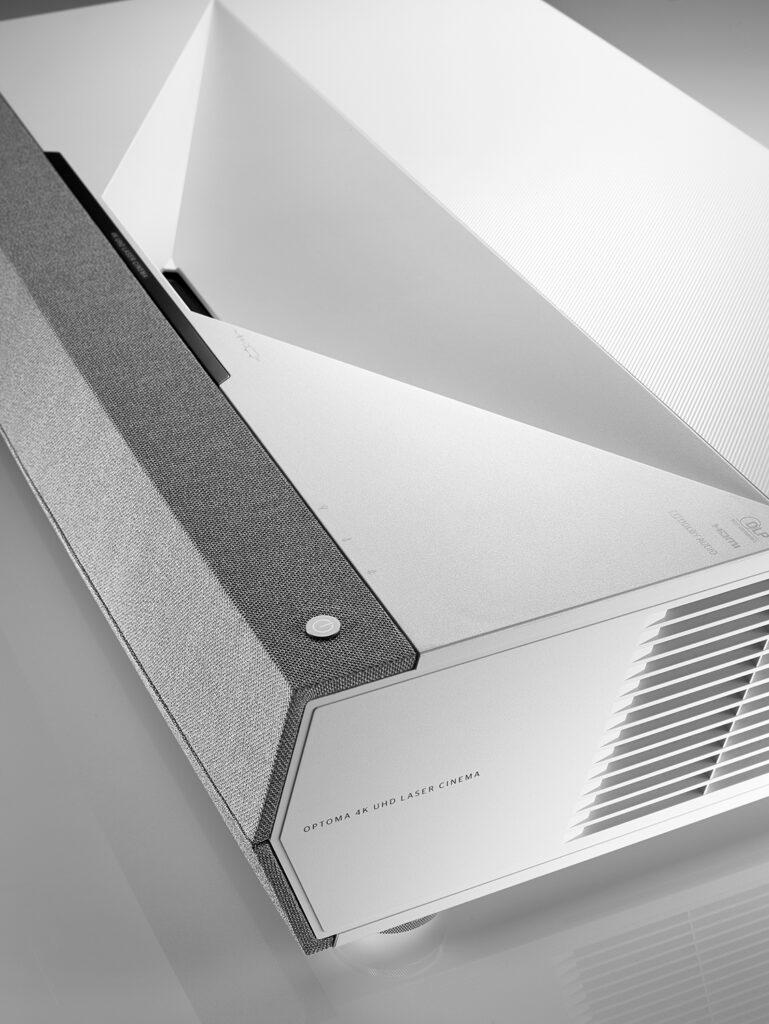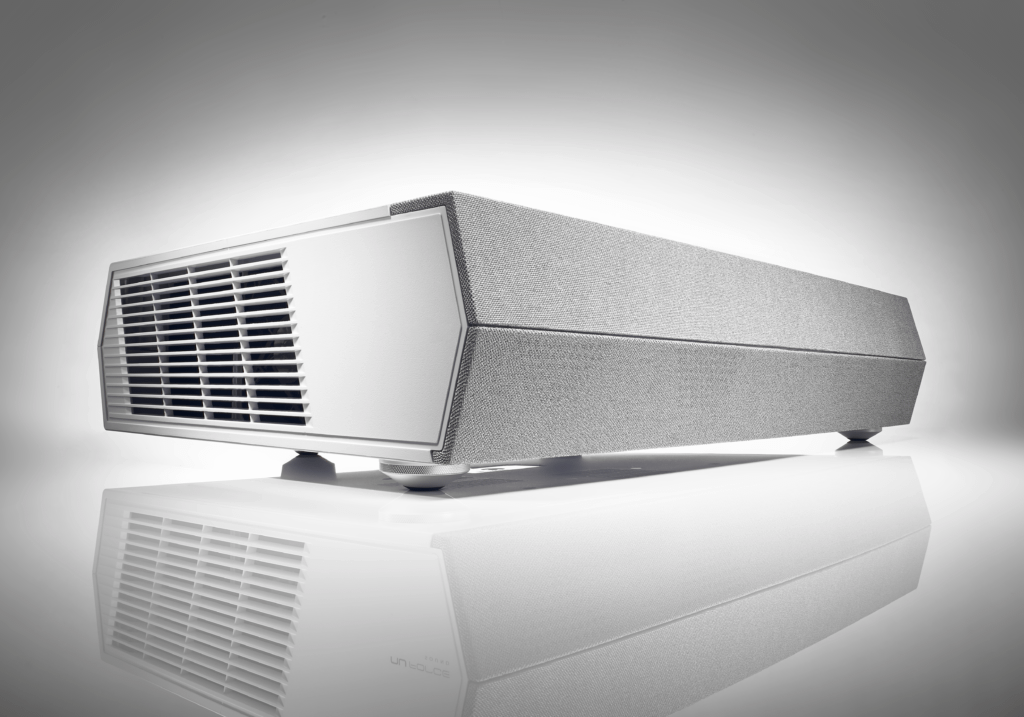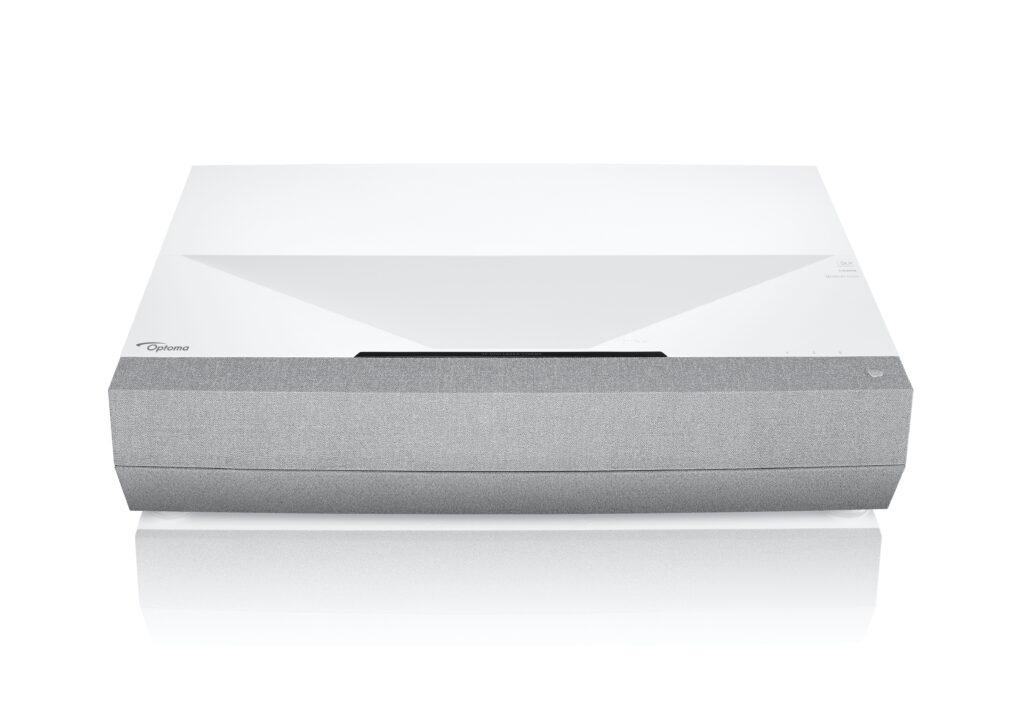
I find that there are two main types of projector enthusiasts: those that are able to dedicate and properly build out a room solely for a projector setup, and those that are kept from those aspirations due to extenuating circumstances. Many times, one of those extenuating circumstances is the inability to mount the projector in a suitable location. The depth of the room might be insufficient for the projector’s throw, a homeowner’s association might have strict rules about installing something on the ceiling, or running a long HDMI cable through the room from sources to the projector might look unseemly. Because of these issues, some might opt for a TV instead, but projectors are still a possibility that shouldn’t be overlooked.
Ultra-short throw (UST) projectors alleviate all of those issues. They can be placed on the same credenza as a TV, mere inches from the screen. No need for mounting on a ceiling, a deep room, or hiding a cable with a throw rug. Optoma’s most recent UST solution is the CinemaX P2, an update to the excellent CinemaX P1 that was released in 2019, and best of all the CinemaX P2’s $3,299 retail price is $500 less than the P1.



Since the Optoma CinemaX P2 sits so close to the screen, it doesn’t look like a traditional projector. The white case has an indentation in the top where the lens sits, and along the front there's a light gray angled grille that covers the 40-watt two-channel, four-speaker array. On the back (the side that faces the screen) are two HDMI 2.0 inputs with HDCP 2.2 (one with ARC), two USB 2.0 ports, an optical out, 3.5mm audio out, and Ethernet connection. There’s an additional USB power and HDMI 1.4 input on the right side. A single button on the top left turns the projector on and off, while all other controls are relegated to the remote. It’s a sleek design that looks attractive on the top of a table, and while it’s significantly deeper than a TV, at 5.12 x 22.68 x 15.08 inches (HWD), it is less than half the width of the average 55-inch TV and much less obtrusive when it’s off.
One of the initial difficulties of setting up an ultra-short throw projector is positioning it correctly. Any slight adjustment can make some significant changes to the geometry of the picture. There’s the ability to correct that in the projector’s menu or by using the SmartFIT app (although I found the app to be finicky), but making those changes can affect picture sharpness and brightness output. Best to spend the time and get it right from the get-go. Optoma includes a template to help with the placement in relation to the screen, but if you already have a screen installed on the wall and a table or credenza in place, the most difficult part is getting the height correct. For a 120-inch diagonal screen, the top of CinemaX P2 needs to be about a foot below the bottom of the screen edge, and the back of the projector needs to be 13.5 inches from the screen (which puts the front of the projector 28.6 inches away from the screen). It takes some time to get the picture just right, but in the end it’s worth it.
If you haven’t yet mounted your screen, I suggest figuring out your projector placement measurements first so you don’t have to come up with a solution to lift the CinemaX P2 up higher. There are adjustable feet, but they are only for fine tuning. If you haven’t yet bought your screen, then I recommend looking into an ambient light rejection (ALR) screen for UST projectors. These are manufactured with microscopic fins on them that reflect the light from the projector out towards your eye, while absorbing or deflecting light from other directions away from you. The result is a brighter, less washed-out image that holds up better to a room with ambient light -- be it from the sun or your room's lighting. Fret not, though, if you have a traditional non-ALR screen. I reviewed the CinemaX P2 with my Stewart Grayhawk and, as you’ll read later, the Cinema picture mode was able to provide enough light for casual afternoon viewing.
Instead of a traditional lamp, the CinemaX P2 uses one of Optoma’s DuraCore laser light engines. It’s IP5X/IP6X certified, which keeps the optical engine free of dust and moisture, and will last up to 30,000 hours in Eco mode (20,000 in Normal) before reaching half brightness. So while the cost of lamp replacements needs to be factored in to the lifetime purchase price of traditional projectors, laser projectors need zero normal maintenance for their life.
The DuraCore light source sends a blue laser through a yellow phosphor before passing through a six-segment RGBRGB color wheel. This is one of the changes from the P1, which used an eight-segment RGBYRGBY color wheel that boosted the brightness at the expense of some color accuracy. Once passing through the color wheel, the light bounces off the DLP chip, out the lens, and onto the screen. A drawback of single-chip DLP projectors with color wheels, like the CinemaX P2, is the possibility of rainbows. I’m not very susceptible to them, but did briefly see them on one occasion. If the rainbow effect bothers you, I’d recommend finding a sample to look at or at least buy the P2 from somewhere that has a good return policy.
The CinemaX P2 uses a 0.47-inch TI chip with XPR technology that pixel shifts the image in order to achieve its 4K resolution. There are those that feel this isn’t real 4K resolution -- or “FauxK” -- and while a side-by-side comparison might show a pixel-shifted image to have less clarity, anyone would be hard pressed to find flaw with the Optoma’s resolution. The image is incredibly sharp even out towards the edges, which are usually a weak spot for UST projectors. At close inspection, the edges of the CinemaX P2 do start to get a tad softer, but it isn’t perceptible from a few feet away.
The small, black metal remote operates via Bluetooth instead of IR. It’s light, only has a half dozen buttons in addition to a directional pad and volume control, and has a dim backlight that won’t blind you in a dark room. The remote doubles as a wand, which becomes a necessity for some of the apps available through the awful Aptoide OS (more below in The Downside). Instead of changing batteries, the remote is chargeable with a USB cable.
The built-in 40-watt sound system consists of two 2-inch full range aluminum drivers and 2.75-inch woofers with ported chambers. There’s good dialogue clarity from the speakers, and the ported chambers help a little with the bass response, but there’s only so much you can expect in that department from a 2.75-inch woofer.
One interesting feature that Optoma added to the P2 is the FRAMED app. Instead of a typical screensaver, the FRAMED app has twelve different curated pieces of art that were created by ten different digital artists. It’s a nice way to add some beautiful works of art to your wall.
How Does the Optoma CinemaX P2 Perform?
While there are six different picture modes on the CinemaX P2, I generally only used two of them for SDR -- Reference and Cinema. Reference was the most accurate, but was also the dimmest and didn’t hold up as well against ambient light as Cinema did, which was a bit bluer than Reference. Additional picture modes include Bright (far too green for serious viewing), HDR Sim. for simulating the HDR effect with SDR content, Game (very blue tinted but acceptable if you need extra brightness), and User, which was virtually identical to Cinema by default. With HDR content, the CinemaX P2 automatically switches to its HDR picture mode (there’s also a dedicated mode for HLG content). If you hire an ISF calibrator, they can access and calibrate five different ISF picture modes -- Day, Night, HDR, HLG, and 3D.
RGB Gain/Bias and color point calibration controls are available for all picture modes. Using Calman calibration software from Portrait Displays, an X-Rite i1Pro3 spectrophotometer, and a Murideo Six-G signal generator, I was able to calibrate Reference picture mode to be even more accurate (out-of-the-box it has a slightly red/orange tint), although there was a slight loss of light output (not an unexpected consequence).
I’ve been slowly working my way through The Clone Wars animated series in chronological episode order on the Disney+ app (I used my Roku Streaming Stick+ for it, not the Aptoide OS). There’s some absolutely fantastic storytelling throughout the series, but I feel it starts to hit its stride when we get to Mandalore and the relationship between Obi-Wan and Duchess Satine. The colors used in the animation looked wonderfully vibrant, particularly the blues and purples in Duchess Satine’s ceremonial robes. In Reference picture mode, to see shadow detail in some of the darker night scenes required the curtains to be drawn or to wait until the evening. Switching to Cinema gave it a little extra kick in brightness as well, and the animation still looked rich, although blues were a little too oversaturated. Sharpness needs to be dialed back a bit to around 3 or 4 from the default. That gets rid of enhancement artifacts but still keeps a nice sharp picture.
Projectors in general have a tough time with HDR due to their lower light output as compared with today's better TVs. But that isn’t to say HDR can’t be enjoyable on a projector when it’s done well, and the CinemaX P2 does it pretty well. When HDR picture mode turns on, there are four different settings -- from darkest to brightest they are Detail, Film, Standard, and Bright -- which can be chosen depending on the overall brightness of the movie. Even with dark titles like Blade Runner 2049, I found Film to be more than adequate to add some depth to the shadows around the furnaces of the orphanage. And when playing around with the setting during brighter scenes -- such as K’s approach to Vegas -- I found Standard to work well. The Bright preset pushed the whites a bit too much.
While the CinemaX P2 has a Game picture mode, gaming mode can be turned on in the menu no matter what picture mode you’re in. It disables extra processing, like PureMotion, to bring down the input lag. Unfortunately it only brings the lag down to 58.4ms. That’s a significant improvement over the 121.5ms I measured without gaming mode turned on, but it still means aiming and firing my weapons in Cyberpunk 2077 felt sluggish. And playing against other players online in games like Overwatch could have a detrimental effect on your rankings.
By far the biggest drawback of the Optoma CinemaX P2 is its streaming OS. Aptoide is awful and I wish it would ride off into the sunset. Or die in a fire, either way, just as long as companies stop using it. It’s unbearably clunky to navigate and some of the most popular streaming apps are severely limited. The directional pad doesn’t work properly with the Netflix login (thankfully the remote wand works). Even worse, it only plays at 480p. Getting a Roku, Fire TV, or some other media streamer is an absolute necessity if you plan on watching any streaming apps.
Not a huge downside, but the low-frequency response of the built-in Dolby system is lacking. If you plan to use the speakers, you’ll need to invest in a subwoofer to connect to the audio out if you want any sort of thump. For the majority of the review time, I turned off the internal speakers and used my surround sound system. Very occasionally on startup the internal speakers would turn on as well and cause an echo effect (the audio delay setting in the menu was different between the two), even though the menu had them listed as off. It was an easy, although annoying fix, toggling it to on and then off again.
The most direct competition to the Optoma CinemaX P2, at least in terms of price, is the VAVA 4K projector. It’s $500 cheaper than the Optoma and has a rated light output of 2,500 lumens, which is 500 less than the P2. This is VAVA’s first projector, and while they definitely have a desire to continue to improve their product -- and have been through firmware updates -- the Optoma is a vastly superior projector, with better grayscale and color accuracy.
Most other UST projectors, such as the Samsung Premiere LSP9T and LG HU85LA, cost up to twice what the Optoma sells for. Samsung has another UST model, the LSP7T, which costs a couple hundred dollars more than the P2, but has less light output.
An interesting release at the end of last year is the Hisense 100L5F Laser TV (it’s really an ultra-short throw projector). It originally sold for $3,999, but at the time of writing can be found for $2,999. And it includes a 100-inch ALR screen. Hisense just announced a version that comes packaged with a 120-inch screen for $5,000.
As the months go on, Optoma is facing more and more competition in the UST projector market. But luckily for the company, the CinemaX P2 is a top-notch model. Even if you don’t get the projector calibrated, the out-of-the-box settings are very good, and when the time is taken to set it up properly, it puts out a crisp, vibrant picture in both SDR and HDR. It could use an additional subwoofer to fill out the sound, and getting an aftermarket streaming stick is an absolute must. But for someone that’s looking for an alternative to a TV, but doesn’t have the throw space for a regular projector, the Optoma CinemaX P2 is an excellent alternative.